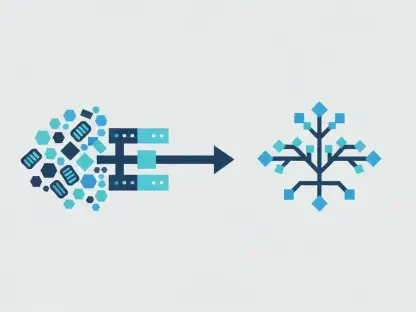In the swiftly changing world of biopharmaceuticals, the role of artificial intelligence (AI) is rapidly expanding, driving interest and speculation about its potential transformative effects on the industry. This landscape isn’t just challenged by scientific demands but also by economic pressures, as evident in companies like Recursion Pharmaceuticals, which, despite experiencing significant share price volatility, remains at the cutting edge of drug discovery with its pioneering technology. The company’s substantial downturn in market value over the past year has not dampened enthusiasm for its innovative methods, which harness AI and machine learning to refine and accelerate the drug development process. The volatility in Recursion’s stock performance raises questions about the wider stability and adaptability of the biopharma sector amid market fluctuations. Yet, it also brings to light the potential of AI-powered solutions to reshape traditional paradigms and offer new avenues for efficiency and funding within the industry. As investors, companies, and enthusiasts look on, the AI revolution in biopharma presents both challenges and unprecedented opportunities.
AI-Driven Innovation at Recursion Pharmaceuticals
Recursion Pharmaceuticals stands out in the biopharmaceutical landscape with its avant-garde approach to drug discovery, leveraging a proprietary platform known as Recursion OS. Unlike conventional methods that rely heavily on trial and error, Recursion OS integrates AI and machine learning with extensive data collection and automation, aiming to make drug discovery more predictive and efficient. This technology functions like an operating system for drug development, aiming to cut down prolonged timelines and introduce more cost-effective pathways. By streamlining the process, Recursion intends to pave the way for breakthroughs at a quicker pace, fundamentally altering the dynamics of pharmaceutical research. The ambition is not just limited to speeding up the discovery; it encapsulates a broader vision of transforming the way the entire industry operates, setting a precedent in innovating beyond the typical pharma protocols.
The strategic licensing of Recursion OS to other pharmaceutical companies marks a significant step beyond internal applications, showcasing its versatility and market potential. Collaborations with giants like Roche and Genentech underscore the platform’s credibility and its broad market applicability. These partnerships not only diversify Recursion’s income but also validate the commercial viability of its technology on a global scale. Such collaborations represent a promising movement in the industry towards more integrated and flexible approaches to tackling drug development challenges. They also open new potential revenue streams, enhancing Recursion’s financial model in a sector known for long lead times between initial development and realized profit. By offering its cutting-edge platform to other market players, Recursion positions itself as a leader not just in innovation but also in reshaping industry norms.
Financial Implications and Challenges
Amidst the innovation, Recursion’s financial standing reveals both the hurdles faced by clinical-stage biotech firms and the enduring promise of new technology-driven strategies. Recent financial reports highlight a net loss of $575 million in the last four quarters, a scenario commonly associated with heavy upfront investments in research and development rather than immediate financial gain. The net margin of -961% and operating cash flow margin of -650% reflect this typical biotech financial strain, where funds are channeled into long-term projects without the guarantee of imminent returns. Despite the concerning figures, this trend is a noted reality for companies entrenched in R&D, where substantial capital expenditure precedes revenue turnover. These numbers represent both a risk and a testament to the scale of innovation being attempted.
However, Recursion remains on firm financial ground, with a minimal debt level relative to its market cap, suggesting a lower financial risk when compared to the average company in the S&P 500. With a robust cash reserve of $500 million—38.3% of its total assets—Recursion has fortified its liquidity position. This provides a crucial cushion, ensuring the continuation of its ambitious projects without immediate capital campaigns. The financial strategy underscores the importance of maintaining fiscal flexibility while focusing on long-term growth and innovation. It highlights the delicate balance between pursuing groundbreaking technology and securing enough financial runway to complete R&D cycles. In the dynamic field of biotech, such strategic financial management is invaluable.
Long-term Potential vs. Risks
The long-term investment potential in Recursion is particularly vested in its burgeoning drug pipeline, which is further available through strategic partnerships and mergers, such as with Exscientia. This merged entity is projected to have a pipeline with peak sales potential exceeding $1 billion, offering promising prospects for investors anticipating future revenue growth. The potential for high returns lies in the eventual successful commercialization of new drugs, a process that AI enhancements could accelerate significantly. Beyond immediate collaborations, Recursion’s strategy pivots on harnessing its AI platform not only for its own drug development but also as a licensable asset to other companies—an approach that presents an additional revenue channel, thereby diversifying income sources.
Nonetheless, there are considerable risks inherent in investing within the biotech industry, compounded by reliance on AI for drug discovery. These risks include the unpredictability of clinical trials, where drug candidates may fail to exhibit the required safety or effectiveness, leading to project terminations and substantial financial retrenchments. Further complicating the landscape, the tight regulatory environment demands rigorous compliance, which can delay or entirely derail commercialization efforts. Recursion’s AI platform, while revolutionary, faces the critical hurdle of substantiating its efficacy and reliability over traditional drug discovery processes, with true validation pending a substantial track record of successful clinical applications. The need for ongoing studies to further prove its value poses significant risks.
Navigating Market Volatility
In the backdrop of its technological and financial journey, Recursion must also navigate the ever-fluctuating market conditions that have historically affected its stock performance. Market volatility, exacerbated by external economic factors such as tariffs and global economic shifts, has previously led to stark fluctuations in Recursion’s stock, outpacing broader market downturns. This erratic stock trajectory underscores an additional layer of uncertainty for investors who must consider not only the company’s innovative edge but also its ability to remain resilient amidst broader market trends. The fall in Recursion’s stock during the market corrections highlights the volatility sensitivity of emerging tech-biotech firms, where rapid innovation often collides with investor caution.
Yet, these market conditions also present opportunities for a company like Recursion that is positioned at the forefront of AI innovation in drug discovery. By focusing on agility and resilience, Recursion can potentially leverage these conditions to expand its market influence and appeal, particularly to those investors looking beyond traditional pharmaceutical approaches. Key to navigating market volatility is Recursion’s strategic ability to prove the practical value of its AI-driven methodologies in tangible results, delivering on the promise of faster and more reliable drug development outcomes. Successfully achieving this could not only stabilize its own market position but also redefine investor confidence across the biopharma sector.
Future Considerations and Conclusions
In the rapidly evolving biopharmaceutical industry, artificial intelligence (AI) is increasingly pivotal, sparking interest and speculation about its transformative impact. This sector faces both scientific and economic pressures, exemplified by Recursion Pharmaceuticals. Despite significant share price fluctuations, Recursion remains a leader in drug discovery through its innovative technologies. Over the past year, the company’s substantial market value decline has not diminished enthusiasm for its unique approach, employing AI and machine learning to streamline and hasten drug development. The volatility in Recursion’s stock performance prompts questions regarding the broader biopharma sector’s stability amid market changes. However, it also highlights AI-powered solutions’ potential to redefine traditional models, offering new paths for efficiency and funding in the industry. As investors, corporations, and enthusiasts observe, the AI revolution in biopharma presents challenges alongside groundbreaking opportunities for innovation and growth.









